Phase-Modulated Continuous-Wave Coherent Ranging Method and Anti-Interference Evaluation
Abstract
:1. Introduction
2. PhMCW Mechanism
3. Ranging Experiments
4. Anti-Interference Capability
5. Conclusions
Author Contributions
Funding
Data Availability Statement
Conflicts of Interest
References
- Zhang, X.; Kwon, K.; Henriksson, J.; Luo, J.; Wu, M.C. A large-scale microelectromechanical-systems-based silicon photonics LiDAR. Nature 2022, 603, 253–258. [Google Scholar] [CrossRef] [PubMed]
- Royo, S.; Ballesta-Garcia, M. An Overview of Lidar Imaging Systems for Autonomous Vehicles. Appl. Sci. 2019, 9, 4093. [Google Scholar] [CrossRef]
- Purdy, T. Bright squeezed light reduces back-action. Nat. Photonics 2019, 14, 1–2. [Google Scholar] [CrossRef]
- Sun, X.; Zhang, L.; Zhang, Q.; Zhang, W. Si Photonics for Practical LiDAR Solutions. Appl. Sci. 2019, 9, 4225. [Google Scholar] [CrossRef]
- Whyte, R.; Streeter, L.; Cree, M.J.; Dorrington, A.A. Application of lidar techniques to time-of-flight range imaging. Appl. Opt. 2015, 54, 9654–9664. [Google Scholar] [CrossRef]
- Bosch, T. Laser ranging: A critical review of usual techniques for distance measurement. Opt. Eng. 2001, 40, 10–19. [Google Scholar] [CrossRef]
- Rogers, C.; Piggott, A.Y.; Thomson, D.J.; Wiser, R.F.; Opris, I.E.; Fortune, S.A.; Compston, A.J.; Gondarenko, A.; Meng, F.; Chen, X.; et al. A universal 3D imaging sensor on a silicon photonics platform. Nature 2021, 590, 256–261. [Google Scholar] [CrossRef]
- Shi, J.W.; Guo, J.I.; Kagami, M.; Suni, P.; Ziemann, O. Photonic technologies for autonomous cars: Feature introduction. Opt. Express 2019, 27, 7627–7628. [Google Scholar] [CrossRef]
- Zhang, L.; Li, Y.; Chen, B.; Wang, Y.; Li, H.; Hou, Y.; Tao, M.; Li, Y.; Zhi, Z.; Liu, X.; et al. Two-dimensional multi-layered SiN-on-SOI optical phased array with wide-scanning and long-distance ranging. Opt. Express 2022, 30, 5008–5018. [Google Scholar] [CrossRef]
- Lee, S.-H.; Kwon, W.-H.; Lim, Y.-S.; Park, Y.-H. Highly precise AMCW time-of-flight scanning sensor based on parallel-phase demodulation. Measurement 2022, 203, 111860. [Google Scholar] [CrossRef]
- Byun, H.; Lee, J.; Jang, B.; Lee, C.; Ha, K. A gain-enhanced silicon-photonic optical phased array with integrated O-band amplifiers for 40-m ranging and 3D scan. In Proceedings of the 2020 Conference on Lasers and Electro-Optics (CLEO), San Jose, CA, USA, 10–15 May 2020. [Google Scholar]
- Behroozpour, B.; Sandborn, P.A.M.; Wu, M.C.; Boser, B.E. Lidar System Architectures and Circuits. IEEE Commun. Mag. 2017, 55, 135–142. [Google Scholar] [CrossRef]
- Taneski, F.; Abbas, T.A.; Henderson, R.K. Laser Power Efficiency of Partial Histogram Direct Time-of-Flight LiDAR Sensors. J. Light. Technol. 2022, 40, 5884–5893. [Google Scholar] [CrossRef]
- Lee, J.; Kim, Y.-J.; Lee, K.; Lee, S.; Kim, S.-W. Time-of-flight measurement with femtosecond light pulses. Nat. Photonics 2010, 4, 716–720. [Google Scholar] [CrossRef]
- Horaud, R.; Hansard, M.; Evangelidis, G.; Ménier, C. An overview of depth cameras and range scanners based on time-of-flight technologies. Mach. Vis. Appl. 2016, 27, 1005–1020. [Google Scholar] [CrossRef]
- Working with Lasers Updated to Include IEC. 2014. Available online: https://slideplayer.com/slide/12202834/ (accessed on 20 March 2023).
- Lum, D.J. Ultrafast time-of-flight 3D LiDAR. Nat. Photonics 2020, 14, 2–4. [Google Scholar] [CrossRef]
- Poulton, C.V.; Byrd, M.J.; Russo, P.; Timurdogan, E.; Khandaker, M.; Vermeulen, D.; Watts, M.R. Long-Range LiDAR and Free-Space Data Communication With High-Performance Optical Phased Arrays. IEEE J. Sel. Top. Quantum Electron. 2019, 25, 1–8. [Google Scholar] [CrossRef]
- Poulton, C.V.; Yaacobi, A.; Cole, D.B.; Byrd, M.J.; Raval, M.; Vermeulen, D.; Watts, M.R. Coherent solid-state LIDAR with silicon photonic optical phased arrays. Opt. Lett. 2017, 42, 4091–4094. [Google Scholar] [CrossRef]
- Zhang, T.; Qu, X.; Zhang, F. Nonlinear error correction for FMCW ladar by the amplitude modulation method. Opt. Express 2018, 26, 11519–11528. [Google Scholar] [CrossRef]
- Kamata, M.; Hinakura, Y.; Baba, T. Carrier-Suppressed Single Sideband Signal for FMCW LiDAR Using a Si Photonic-Crystal Optical Modulators. J. Light. Technol. 2020, 38, 2315–2321. [Google Scholar] [CrossRef]
- Shi, P.; Lu, L.; Liu, C.; Zhou, G.; Xu, W.; Chen, J.; Zhou, L. Optical FMCW Signal Generation Using a Silicon Dual-Parallel Mach-Zehnder Modulator. IEEE Photonics Technol. Lett. 2021, 33, 301–304. [Google Scholar] [CrossRef]
- Kittlaus, E.A.; Eliyahu, D.; Ganji, S.; Williams, S.; Matsko, A.B.; Cooper, K.B.; Forouhar, S. A low-noise photonic heterodyne synthesizer and its application to millimeter-wave radar. Nat. Commun. 2021, 12, 4397. [Google Scholar] [CrossRef] [PubMed]
- Zhang, X.; Pouls, J.; Wu, M.C. Laser frequency sweep linearization by iterative learning pre-distortion for FMCW LiDAR. Opt. Express 2019, 27, 9965–9974. [Google Scholar] [CrossRef] [PubMed]
- Popko, G.B.; Gaylord, T.K.; Valenta, C.R. Interference measurements between single-beam, mechanical scanning, time-of-flight lidars. Opt. Eng. 2020, 59, 053106. [Google Scholar] [CrossRef]
- Hwang, I.-P.; Lee, C.-H. Mutual Interferences of a True-Random LiDAR With Other LiDAR Signals. IEEE Access. 2020, 8, 124123–124133. [Google Scholar] [CrossRef]
- Grollius, S.; Buchner, A.; Ligges, M.; Grabmaier, A. Probability of Unrecognized LiDAR Interference for TCSPC LiDAR. IEEE Sens. J. 2022, 22, 12976–12986. [Google Scholar] [CrossRef]
- Lee, B.-C.; Choi, B.-C.; Bang, H.-S.; Koh, Y.N.; Han, K.-Y. Study on Measurement Error Reduction Using the Internal Interference Light Reduction Structure of a Time-of-Flight Sensor. IEEE Sens. J. 2022, 22, 12967–12975. [Google Scholar] [CrossRef]
- Dashpute, A.; Anand, C.; Sarkar, M. Depth Resolution Enhancement in Time-of-Flight Cameras Using Polarization State of the Reflected Light. IEEE Trans. Instrum. Meas. 2019, 68, 160–168. [Google Scholar] [CrossRef]
- Jiménez, D.; Pizarro, D.; Mazo, M.; Palazuelos, S. Modeling and correction of multipath interference in time of flight cameras. Image Vis. Comput. 2014, 32, 1–13. [Google Scholar] [CrossRef]
- Popko, G.B.; Gaylord, T.K.; Valenta, C.R.; Turner, M.D.; Kamerman, G.W. Signal interactions between lidar scanners. In Laser Radar Technology and Applications XXIV; SPIE: Bellingham, WA, USA, 2019. [Google Scholar]
- Carballo, A.; Lambert, J.; Monrroy-Cano, A.; Wong, D.R.; Narksri, P.; Kitsukawa, Y.; Takeuchi, E.; Kato, S.; Takeda, K. LIBRE: The Multiple 3D LiDAR Dataset. In Proceedings of the 2020 IEEE Intelligent Vehicles Symposium (IV), Las Vegas, NV, USA, 19 October–13 November 2020. [Google Scholar]
- Thurn, K.; Ebelt, R.; Vossiek, M. Noise in Homodyne FMCW radar systems and its effects on ranging precision. In Proceedings of the 2013 IEEE MTT-S International Microwave Symposium Digest (MTT), Seattle, WA, USA, 2–7 June 2013. [Google Scholar]
- Ljung, G.M.; Box, G.E. On a Measure of Lack of Fit in Time Series Models. Biometrika 1978, 65, 297–303. [Google Scholar] [CrossRef]
- Li, Y.; Chen, B.; Na, Q.; Xie, Q.; Tao, M.; Zhang, L.; Zhi, Z.; Li, Y.; Liu, X.; Luo, X.; et al. Wide-steering-angle high-resolution optical phased array. Photonics Res. 2021, 9, 2511–2518. [Google Scholar] [CrossRef]
- Poulton, C.V.; Byrd, M.J.; Russo, P.; Moss, B.; Shatrovoy, O.; Khandaker, M.; Watts, M.R. Coherent LiDAR With an 8,192-Element Optical Phased Array and Driving Laser. IEEE J. Sel. Top. Quantum Electron. 2022, 28, 1–8. [Google Scholar] [CrossRef]
- Velodyne. Velodyne. Available online: https://velodynelidar.com/ (accessed on 20 March 2023).
- Robosense. Robosense. Available online: https://www.robosense.cn/ (accessed on 20 March 2023).
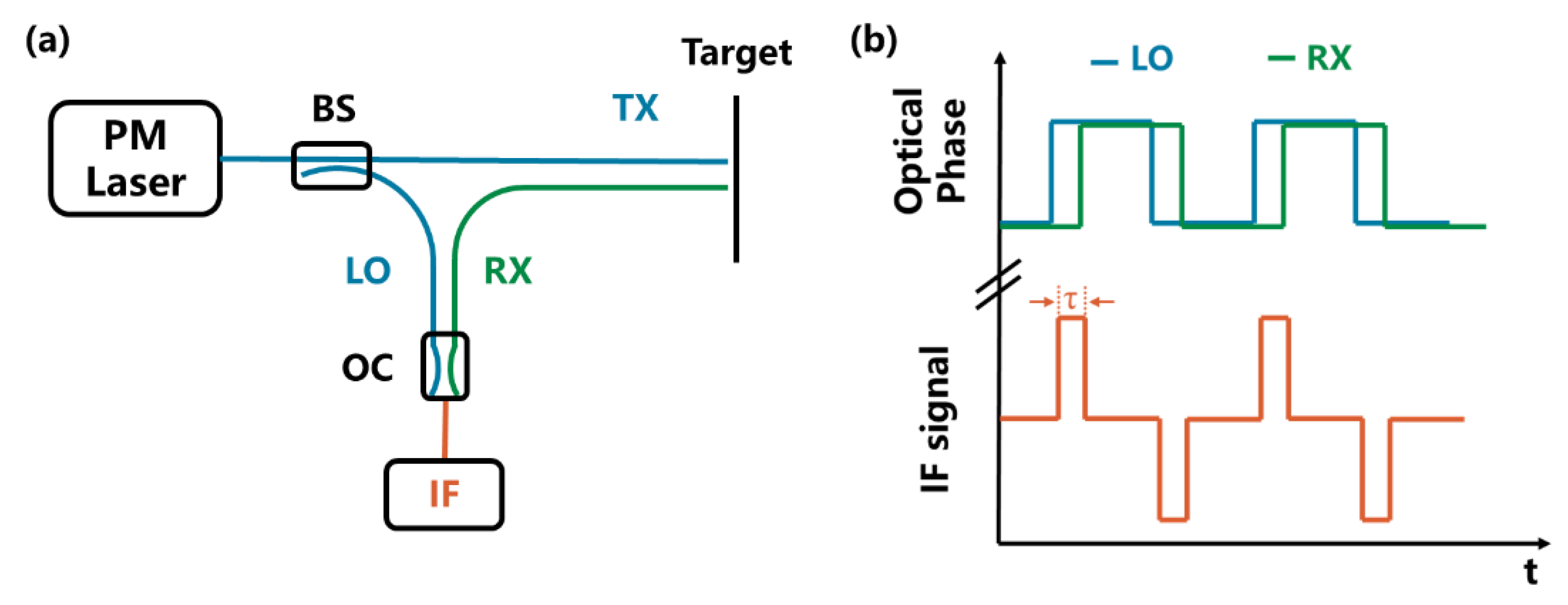
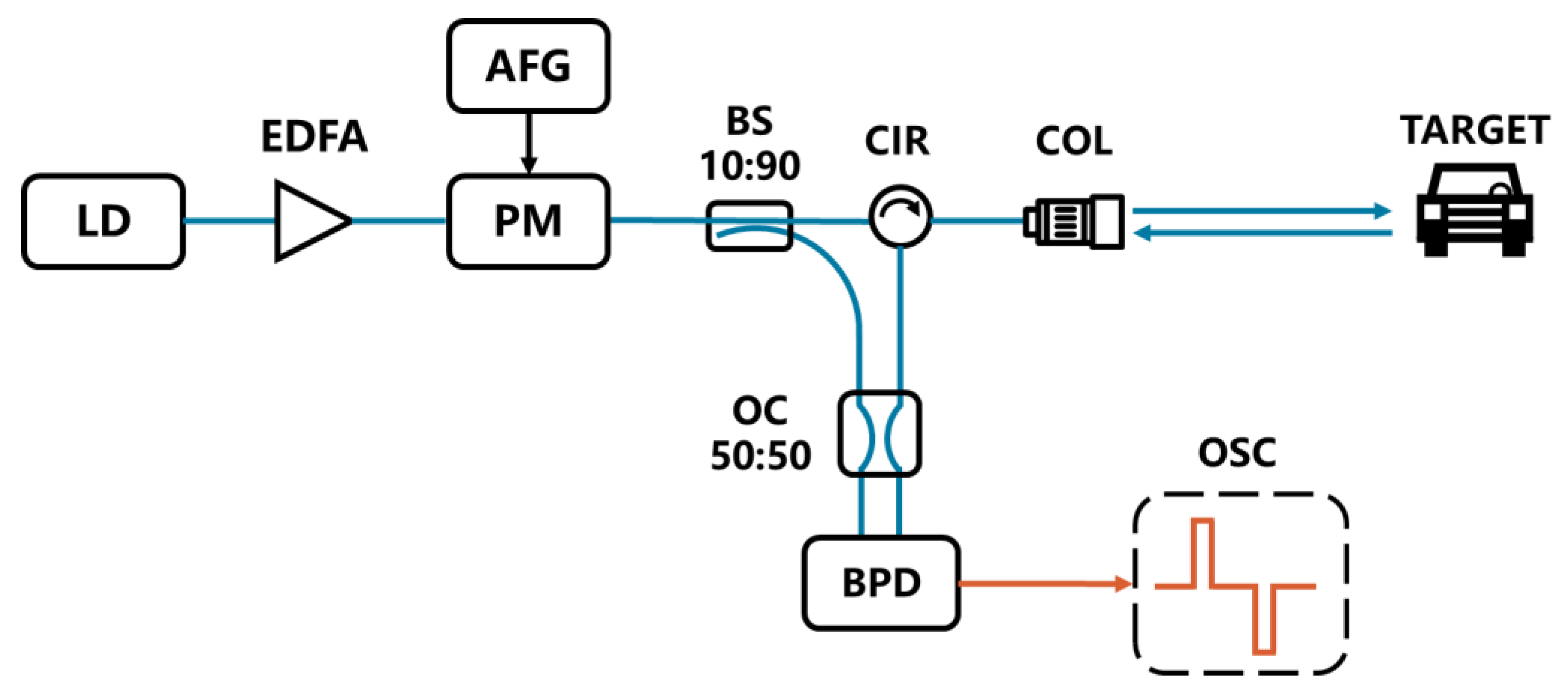
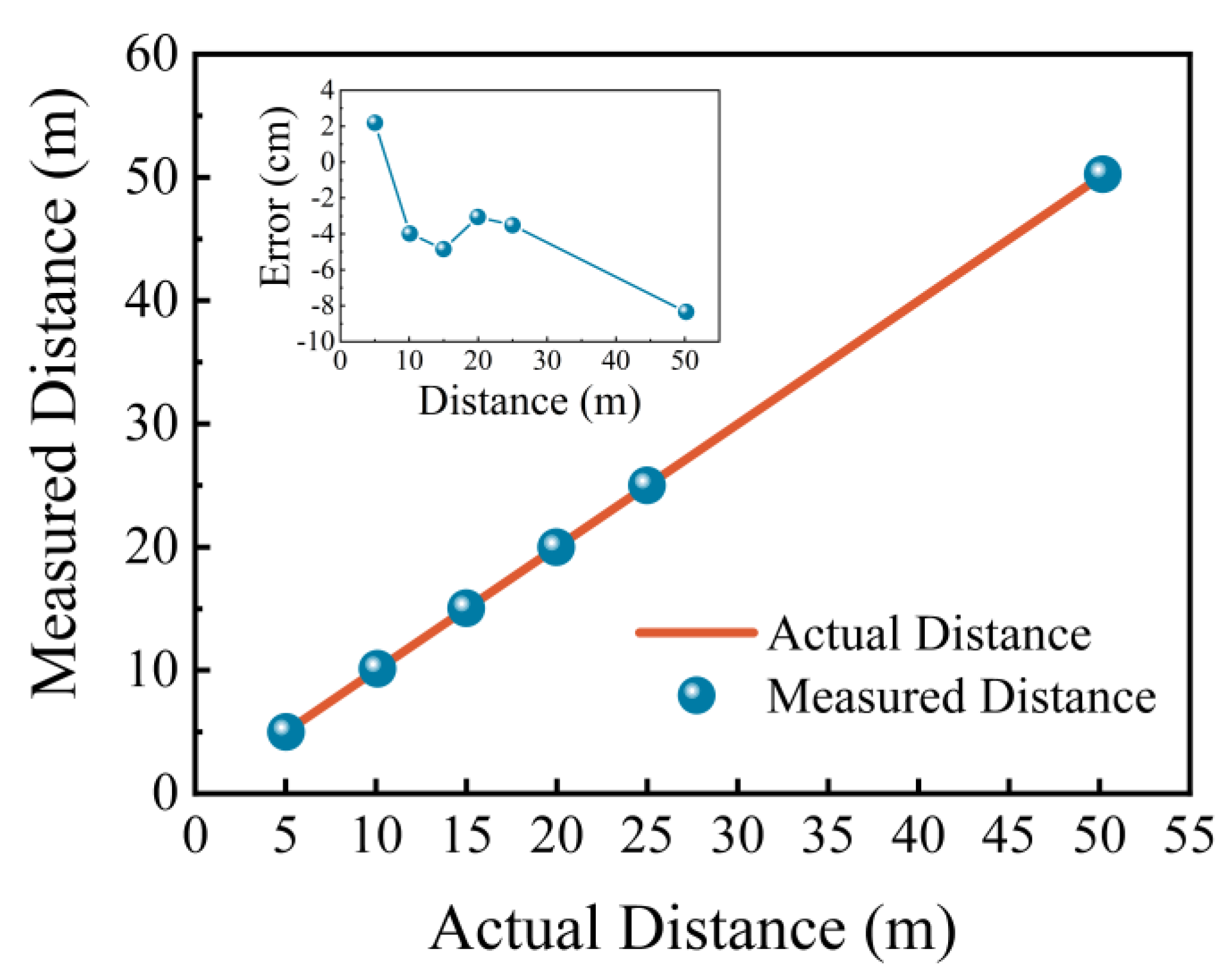
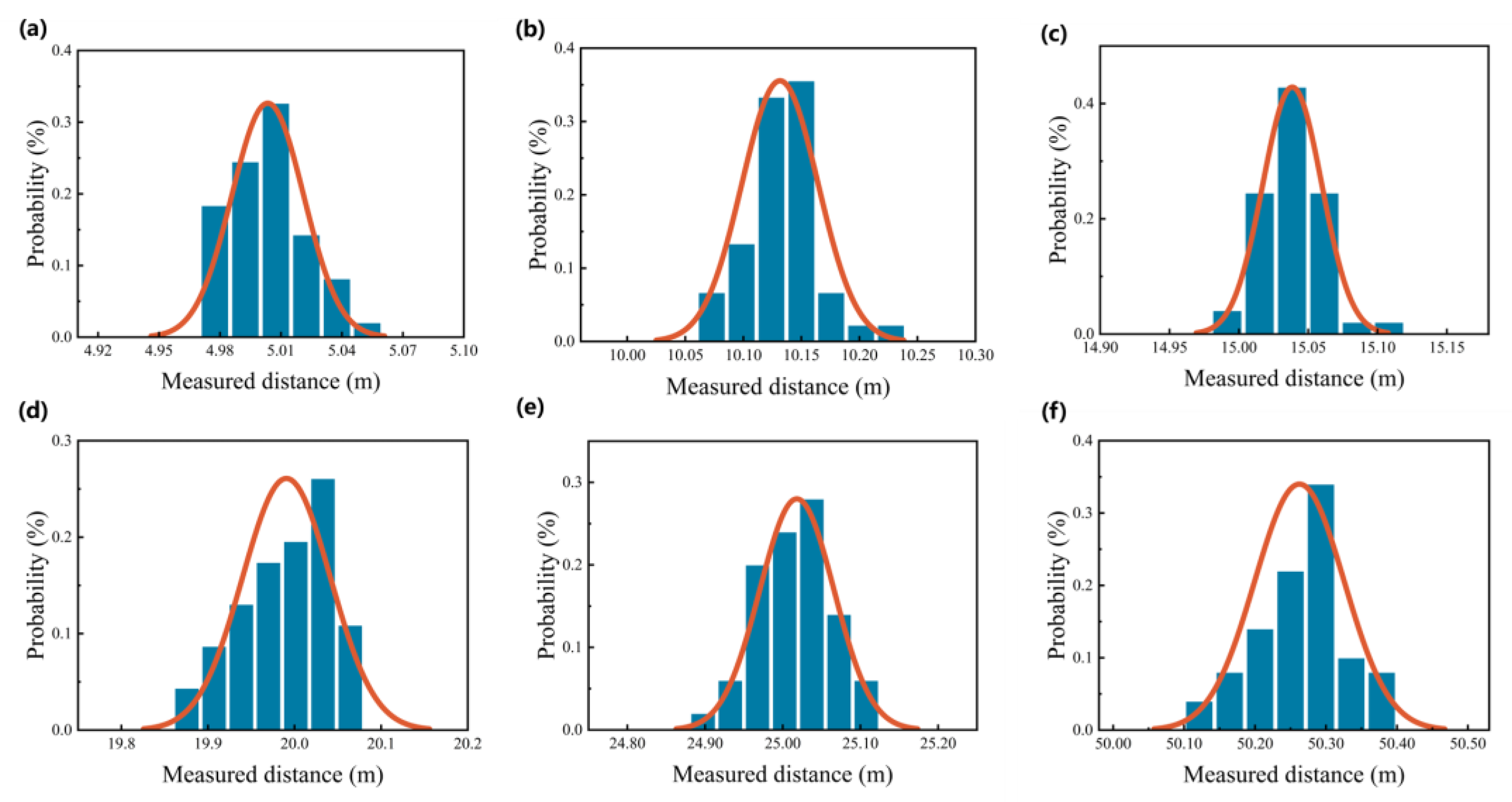
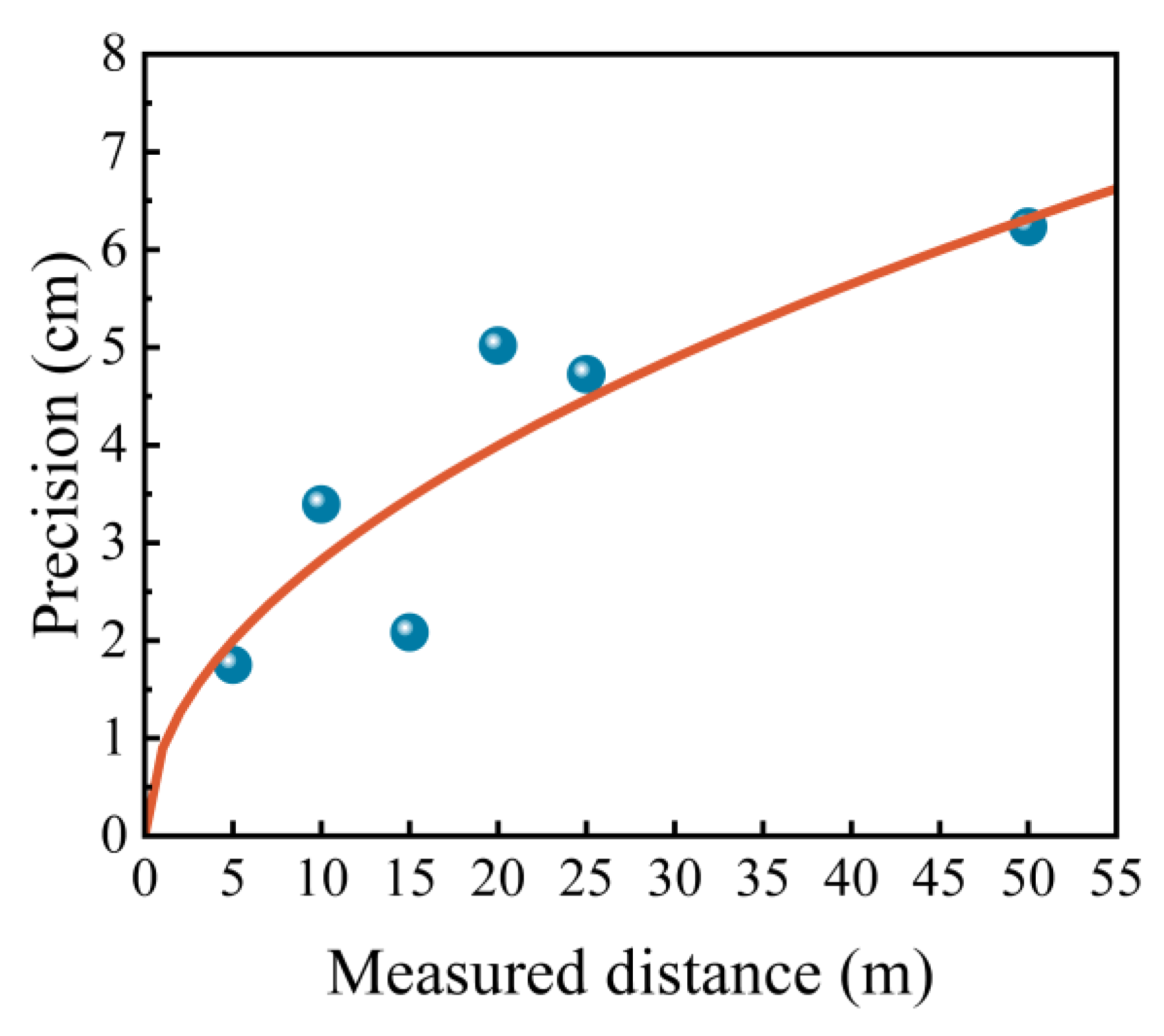
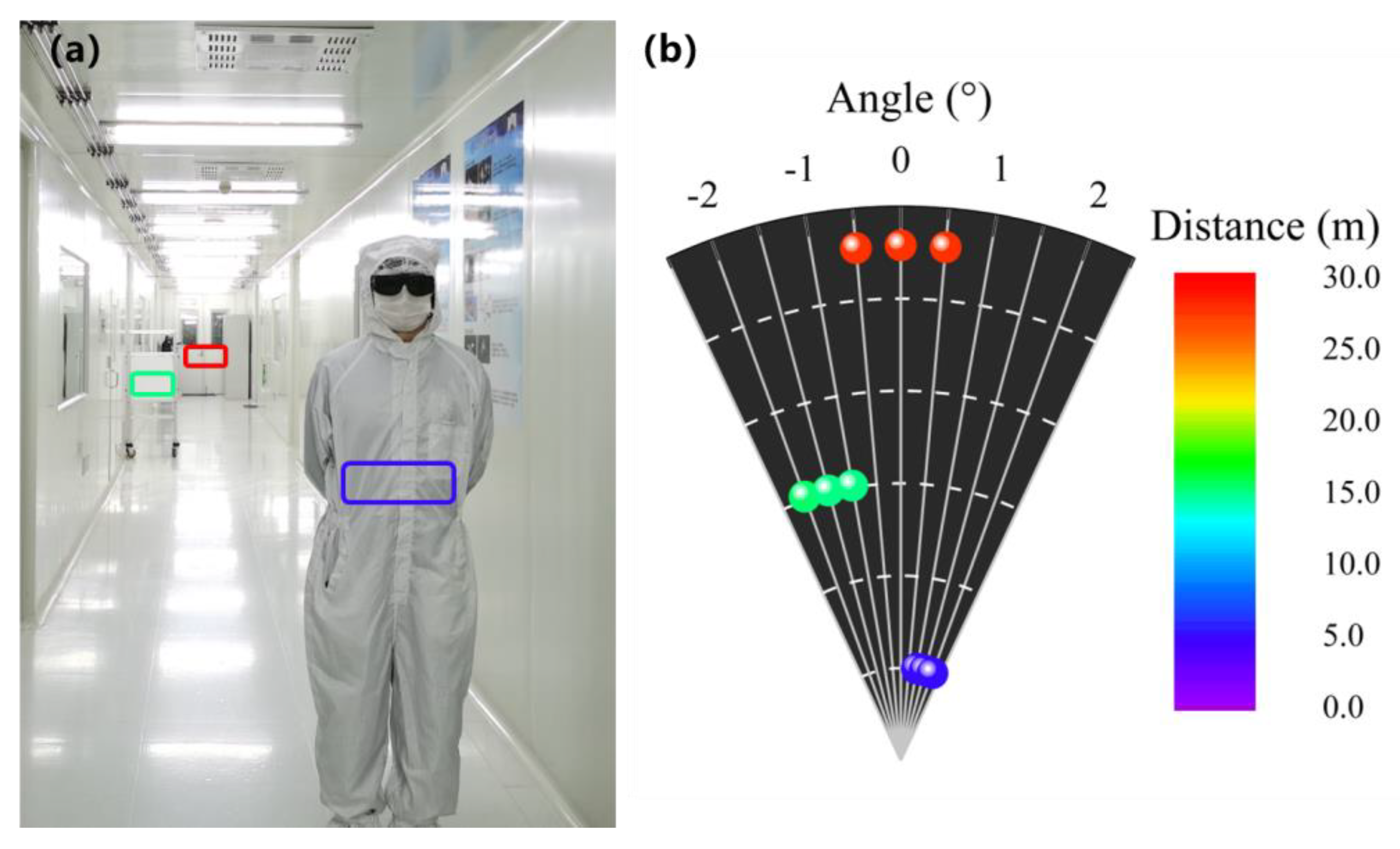
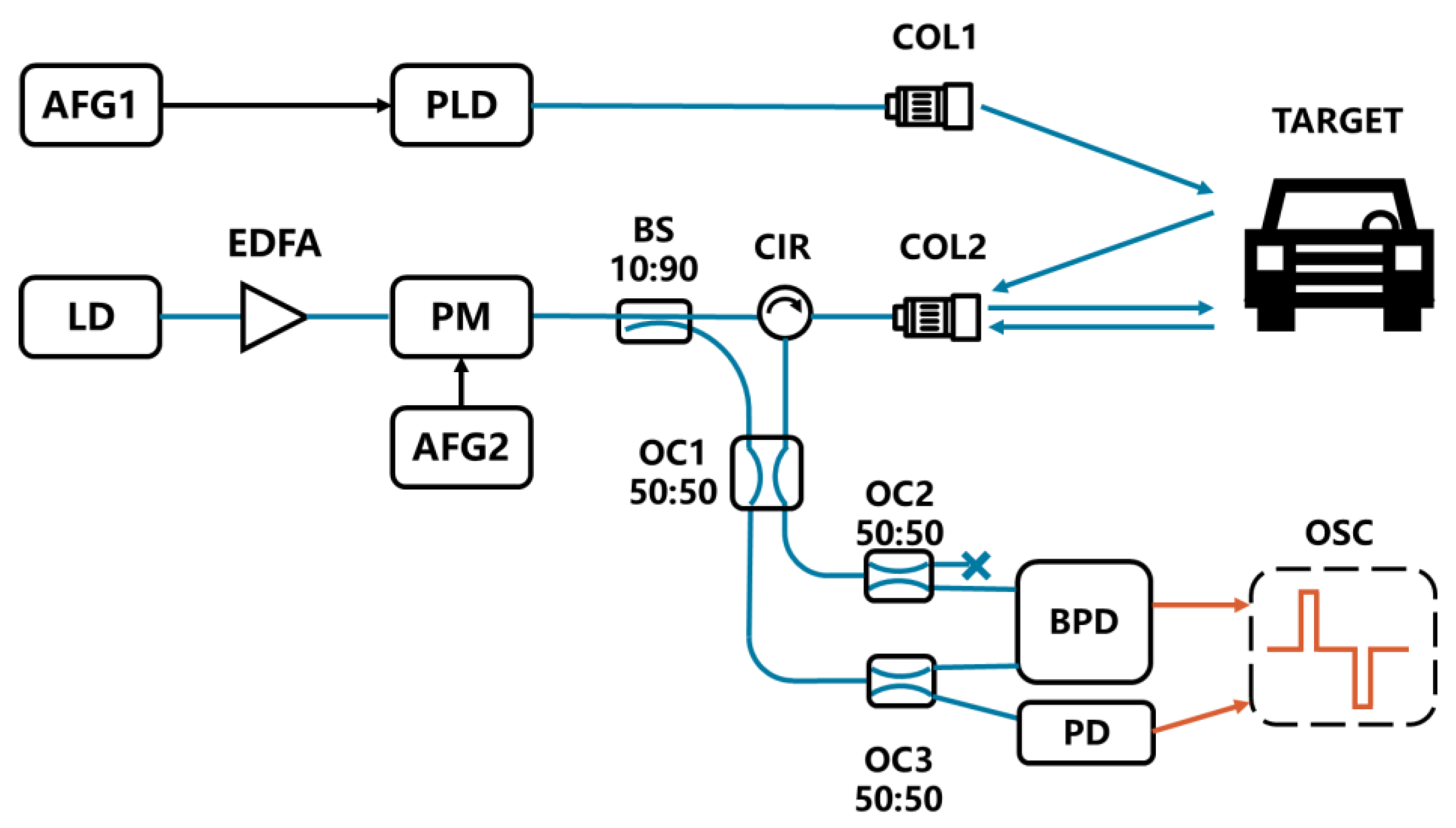




| d (m) | 2 | 3 | 4 | 5 | 6 | 7 |
|---|---|---|---|---|---|---|
| (cm) | 2.393 | 2.407 | 2.129 | 2.302 | 2.261 | 2.223 |
| (cm) | 2.463 | 2.336 | 2.199 | 2.160 | 2.348 | 2.215 |
| (cm) | −0.070 | 0.071 | −0.070 | 0.142 | −0.087 | 0.008 |
| d (m) | 2 | 3 | 4 | 5 | 6 | 7 |
|---|---|---|---|---|---|---|
| (cm) | 2.006 | 2.088 | 2.039 | 2.089 | 2.043 | 2.116 |
| (cm) | 2.039 | 2.07 | 2.016 | 2.088 | 2.081 | 2.103 |
| (cm) | −0.033 | 0.018 | 0.023 | 0.001 | −0.038 | 0.013 |
| Distance (m) | Precision (cm) | Ref | Feature | |
|---|---|---|---|---|
| autonomous vehicle requirement | 50 m (blind zone detection) 100–150 m (pedestrian detection) | cm range | [32] |
|
| FMCW | 75 | 0.33 | [7] |
|
| 100 | 5.09 | [35] | ||
| 35 | / | [36] | ||
| Commercial ToF | 120 | 5 | [37] |
|
| 150 | 10 | [38] | ||
| PhMCW | 100 | 8 | This work |
|
Disclaimer/Publisher’s Note: The statements, opinions and data contained in all publications are solely those of the individual author(s) and contributor(s) and not of MDPI and/or the editor(s). MDPI and/or the editor(s) disclaim responsibility for any injury to people or property resulting from any ideas, methods, instructions or products referred to in the content. |
© 2023 by the authors. Licensee MDPI, Basel, Switzerland. This article is an open access article distributed under the terms and conditions of the Creative Commons Attribution (CC BY) license (https://creativecommons.org/licenses/by/4.0/).
Share and Cite
Zhang, M.; Wang, Y.; Hu, Q.; Zhao, S.; Liang, L.; Chen, Y.; Lei, Y.; Qiu, C.; Jia, P.; Song, Y.; et al. Phase-Modulated Continuous-Wave Coherent Ranging Method and Anti-Interference Evaluation. Appl. Sci. 2023, 13, 5356. https://doi.org/10.3390/app13095356
Zhang M, Wang Y, Hu Q, Zhao S, Liang L, Chen Y, Lei Y, Qiu C, Jia P, Song Y, et al. Phase-Modulated Continuous-Wave Coherent Ranging Method and Anti-Interference Evaluation. Applied Sciences. 2023; 13(9):5356. https://doi.org/10.3390/app13095356
Chicago/Turabian StyleZhang, Mingshi, Yubing Wang, Qian Hu, Shuhua Zhao, Lei Liang, Yongyi Chen, Yuxin Lei, Cheng Qiu, Peng Jia, Yue Song, and et al. 2023. "Phase-Modulated Continuous-Wave Coherent Ranging Method and Anti-Interference Evaluation" Applied Sciences 13, no. 9: 5356. https://doi.org/10.3390/app13095356





